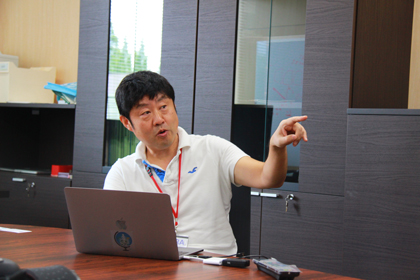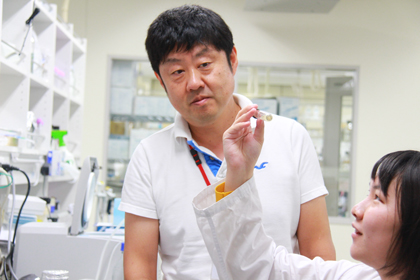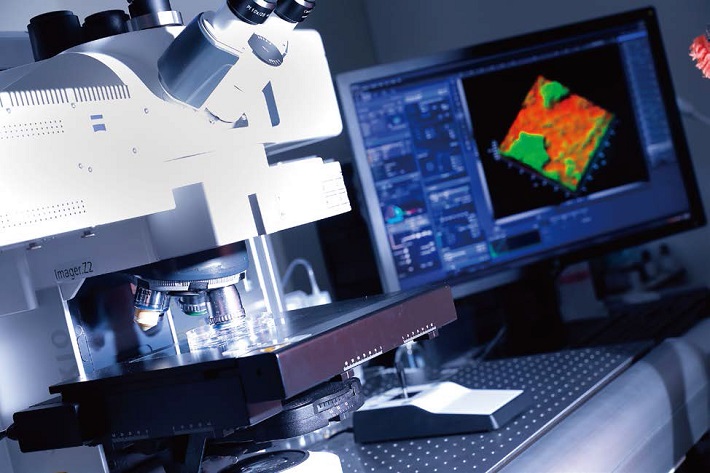TSUKUBA FRONTIER
#19 Decoding Their "Language" to Pave the Way for a New Phase of Coexistence with Humanity
Microbes such as infectious viruses and bacteria that regulate the environment of the intestinal tract directly affect the human body, but some are also used for purposes such as fermentation and decomposition of food, water treatment, and soil improvement. If you closely study their ecology, you will be amazed by the ability of these tiny single-celled organisms to communicate on the community level and by the strategies they employ to survive.
Professor NOMURA Nobuhiko, Faculty of Life and Environmental Sciences

■ Microbes, the rulers of the earth

Hundreds of millions of years after the formation of the earth about 4.6 billion years ago, single-celled microbes emerged as the first life forms. Multicellular organisms did not appear until about 900 million years ago, which means that microbes have been the only living things on earth for most of its history. During that time, they repeatedly endured major changes in the environment and avoided extinction even with the emergence of multicellular organisms. Furthermore, microbes have lived on while also becoming a part of plants, animals, and of course humans as well.
One type of microbe that has employed this strategy is gut bacteria, which have recently become a popular topic. This goes to show how microbes play an essential role in human life. Considering this, you could even say that microbes are what maintain and control life on earth. While they do have undesirable effects such as causing illness, it would be wise to become highly familiar with microbes and live alongside them while carefully regulating their capabilities. Prof. Nomura and his team are working on a research project to achieve that goal.
■ Understanding microbes as a "community"
Long before we as a species were aware of the existence of microbes, we learned how to use them in fermentation and brewing through experience and built civilizations. Once the microscope was invented and microbes were discovered in 1680, we started actively utilizing them for applications such as antibiotics. The contributions of microbes to the progress of humanity are undeniable.
Through research on microbes themselves, we have learned that despite being individual cells, they do not behave as single units but rather as units of hundreds of millions, and also that various types of microbes form communities and coexist with one another. If they were human, this would be like forming a single community (called a "biofilm" in the case of microbes) with humans of other ethnicities and races, and even as broad as other species such as dogs. They aid one another, and sometimes compete with one another, but stay together as a community without completely destroying each other. They form various patterns depending on the environment, and collectively exhibit behavior resembling a single multicellular organism, so to speak.
■ Advanced communication

Microbes connect to one another in a network resembling neurons. When they form a community, they release various chemicals extracellularly. This is their "language". When a cell takes up a chemical, a gene switches on or off and this switch triggers a specific behavior. If this action is inhibited by genetic manipulation, the microbes lose their ability to form communities, which reduces their potential to respond to environmental changes. Microbes use that power when they have gained leadership of the community by communication. In his research project, Prof. Nomura discovered this behavior and spurred on global research on biofilms.
Some language that microbes use is a common language that different species can understand, like English, whereas other languages can only be understood by members of a certain species. Communication styles also differ between microbes in unique ways, and the coexistence of all of these microbes in a group creates a highly diverse kind of community. This may hold the key to how these tiny single-celled organisms have been able to survive for billions of years.
■ Imaging analysis
Recent advances in analytical technology have propelled biofilm research forward. We used to analyze genes by destroying cells, but now we can observe movement of living communities in 3D in real time using a confocal microscope. Prof. Nomura and his team, too, are using world-class imaging analysis technology like this for their research project.
Seeing is believing. Pictures and videos are important tools for sharing research findings in a format that anyone can understand intuitively. This is why Prof. Nomura's research requires not only biology but also physics and engineering. Knowledge of chemistry and informatics is also essential to understanding communication and thus the research group also includes researchers from these fields.
■ Working toward smart coexistence with microbes
Microbes have been used to treat water since the early 1900s, and today many people are trying to improve bodily health by introducing or eliminating certain microbes. However, we do not yet know the true potential of microbes. They only want to create a good living environment for themselves, and do not need to use their abilities to meet human demands.
By understanding the language of microbes, we humans can gain the skills to communicate with them. If we can send microbes messages and activate and limit their innate abilities, we should be able to build a smart symbiotic relationship without thinking of microbes in the black and white terms of "useful" and "bad".

*JST/ERATO NOMURA Microbial Community Control Project
NOMURA Microbial Community Control Project Website![]()
Article by Science Communicator at the Office of Public Relations


